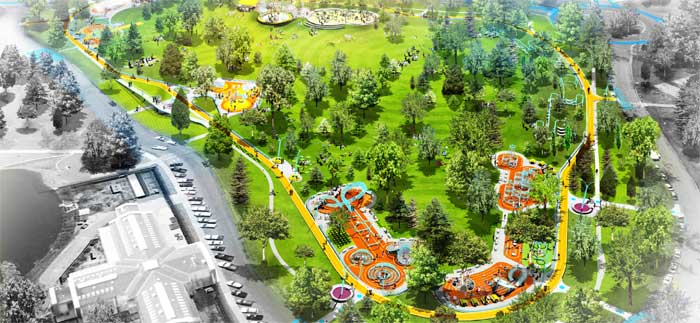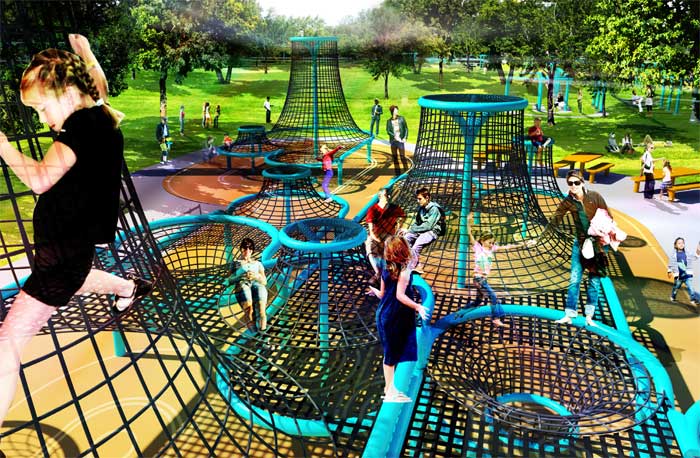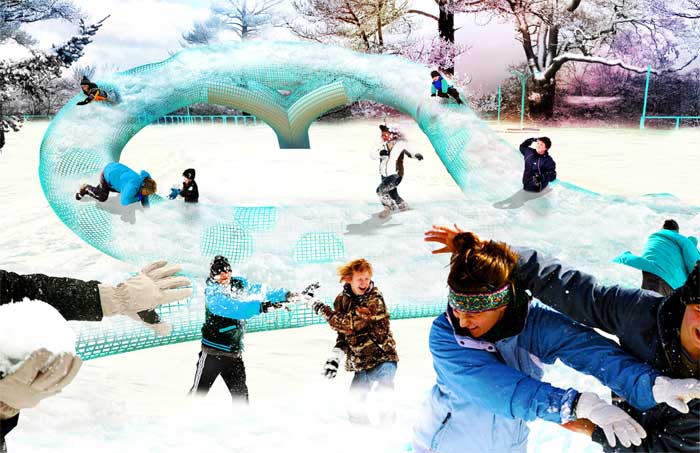
The Reimagine City Park design will add six recreational areas within a 13-acre plot between the tennis courts and the MLK statue. (Photos courtesy of Department of Parks and Rec)
Raised glass walkways, flexible tubes to crawl through, talking abstract structures—this is not the City Park people know, but it is fast approaching. Denver Department of Parks and Recreation plans to make City Park a regional attraction. The estimated $5-million “Reimagine Play” City Loop project will cover 13 acres, although most of that will remain open space. Denver officials are targeting Spring 2015 to begin construction.
“We thought ‘let’s not just do some patchwork but reimagine what this park can be.’ It’s very exciting,” Dist. 8 Councilman Albus Brooks said.
The idea budded from the old Dustin Redd playground at the west end of the park. Built in 1996 by Denver volunteers, the playground has been a favorite for nearby families. Over the years, wornout parts of the largely wooden playground have been removed rather than repaired.
“For many years now, folks have said the playground is falling apart,” Brooks said, who has often brought his 6-, 4- and 2-year-olds there to play.
In January 2011, Parks and Recreation started soliciting proposals to redesign the playground. In 2012 they held a design competition for the public to vote. About 12 designs were submitted—some replaced the existing playground with a plastic one and others went more outside the box. In October 2012, they announced the winning design by PORT Architecture + Urbanism, based out of Chicago.
The conceptual design transforms the park’s underused space. It removes the Dustin Redd playground and adds a modern play area equipped with super-sized swings, artificial rain, giant tunnels, climbing structures and boulder fields.
As the name implies, the preliminary design has a loop around a 13-acre plot of land. It has a rubberized track for running, walking, cross-country skiing or snowshoeing.

Twenty-two-foot high climbing nets will be part of the City Park West Cluster where adults and kids can play.
The plan also adds a city plaza where people can meet and socialize. The plan includes bike racks, movable furnishings, food trucks, holiday markets, parties and a performance stage. An activities kiosk has Wi-Fi access, a book-share library and equipment rentals—everything from giant foam blocks to Ping-Pong tables.
“We’re going to have the best intergenerational play area. It’s going to be part of the whole experience of City Park,” Brooks said.
Parks and Recreation spokesperson Jeff Green says the idea started by reimagining the word play. “If you go to the park and ride your bike or run, you might call that play. If you go to relax and read a book, that might be play. If you go to climb structures, that might be play. So why not create something that has all those elements?”
Some neighbors disagree and wonder why such a big project is necessary.
“To impose this plastic and somewhat garish facility on the space is impinging on the freedoms of the people who use it,” Park Hill resident Holly Joyce said.
Joyce is among a group of concerned residents who started the “Stop City Loop” initiative earlier this year.
The group unites generations of people screaming at the Denver Department of Parks and Recreation. Some of them are longtime Park Hill residents who have successfully stopped nearly every big city plan for the park over the last 20 years.
“Each administration comes in with the open field to do what they want, and the precedent doesn’t mean anything,” said Tom Morris, who lives in South City Park and opposed converting the pavilion into Denver Parks and Rec offices. He advised a group of volunteer lawyers who successfully defeated the idea.
“Why can’t you just let a park be a park?” Park Hill resident Dave Felice said. For years, Felice has fought to keep events in the park free and open to the public. In 2007 he stopped the Mile High Music Festival from coming to the park.
Their main concern with the City Loop is parking and congestion. They say events at the park already overwhelm the neighborhood. But Jeff Green says the planning board is beginning to figure out more parking.
Other concerns include: sanitation, less open space, vandalism and monitoring people sleeping in the tubes.
While the group believes the project will not happen, they are more nervous than they were in their previous battles.
They say there was no public process until the project was already decided. “The department tried to have a public process, but they abused it. The public was only a part of it in a controlled way,” Morris said.
Green completely disagrees. Over the past two years, he says they’ve held more than 45 public meetings about the City Loop, including one on parking that no one attended.
“We can’t just go out and hold a meeting and say ‘everyone come and tell us everything you think about this.’ We hold meetings and present options and let people tell us about the options, which is what we did with City Loop.”
Even though no one attended the parking meeting, he says they will readdress that issue and have more public meetings.

Crawling tubes and slides will be big enough for adults and kids, which makes residents wonder about sanitation and monitoring people sleeping in the tubes.
The Department of Parks and Recreation is beginning to look for donors and seek grants, which will fund the bulk of the project. Meanwhile, the “Stop City Loop” group is meeting with neighborhood groups and gearing up to “scream bloody murder.”
To learn more about the project, visit http://www.denvergov.org/dpr/DenverParksandRecreation/Planning/CityLoop/tabid/444595/Default.aspx. To learn more about the “Stop City Loop” initiative or take a survey, visit StopCityLoop.org.



0 Comments